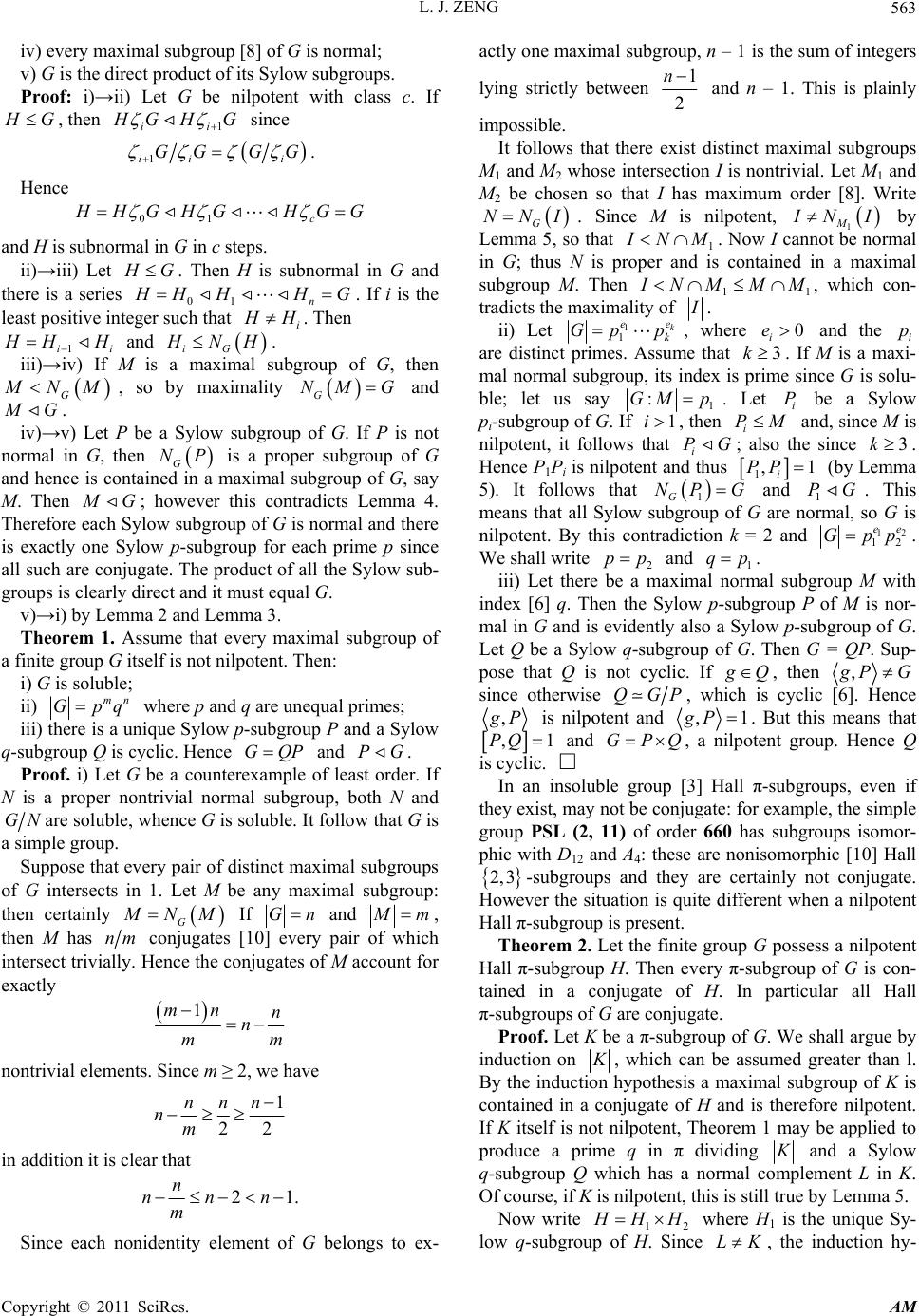
L. J. ZENG563
iv) every maximal subgroup [8] of G is normal;
v) G is the direct product of its Sylow subgroups.
Proof: i)→ii) Let G be nilpotent with class c. If
G, then 1ii
GH G
since
1ii i
GG GG
.
Hence
01 c
HGHG HGG
and H is subnormal in G in c steps.
ii)→iii) Let
G. Then H is subnormal in G and
there is a series 01n
HH HG
i
. If i is the
least positive integer such that
H. Then
1ii
HH
and
iG
NH.
iii)→iv) If M is a maximal subgroup of G, then
G
NM, so by maximality
G
NM G
and
G.
iv)→v) Let P be a Sylow subgroup of G. If P is not
normal in G, then is a proper subgroup of G
and hence is contained in a maximal subgroup of G, say
M. Then
G
NP
G; however this contradicts Lemma 4.
Therefore each Sylow subgroup of G is normal and there
is exactly one Sylow p-subgroup for each prime p since
all such are conjugate. The product of all the Sylow sub-
groups is clearly direct and it must equal G.
v)→i) by Lemma 2 and Lemma 3.
Theorem 1. Assume that every maximal subgroup of
a finite group G itself is not nilpotent. Then:
i) G is soluble;
ii) mn
Gpq where p and q are unequal primes;
iii) there is a unique Sylow p-subgroup P and a Sylow
q-subgroup Q is cyclic. Hence and . GQPPG
Proof. i) Let G be a counterexample of least order. If
N is a proper nontrivial normal subgroup, both N and
GNare soluble, whence G is soluble. It follow that G is
a simple group.
Suppose that every pair of distinct maximal subgroups
of G intersects in 1. Let M be any maximal subgroup:
then certainly
G
NM If Gn and
m
,
then M has nm conjugates [10] every pair of which
intersect trivially. Hence the conjugates of M account for
exactly
1mn n
n
mm
nontrivial elements. Since m ≥ 2, we have
1
22
nnn
nm
in addition it is clear that
21.
n
nnn
m
Since each nonidentity element of G belongs to ex-
actly one maximal subgroup, n – 1 is the sum of integers
lying strictly between 1
2
n
and n – 1. This is plainly
impossible.
It follows that there exist distinct maximal subgroups
M1 and M2 whose intersection I is nontrivial. Let M1 and
M2 be chosen so that I has maximum order [8]. Write
G
NNI. Since M is nilpotent,
1
M
NI by
Lemma 5, so that 1
NM
. Now I cannot be normal
in G; thus N is proper and is contained in a maximal
subgroup M. Then 11
NM MM
, which con-
tradicts the maximality of
.
ii) Let 1
1k
e
pe
e
Gpk, where and the i
are distinct primes. Assume that . If M is a maxi-
mal normal subgroup, its index is prime since G is solu-
ble; let us say
0
i
3
p
k
1
:GMp
. Let i be a Sylow
pi-subgroup of G. If , then i and, since M is
nilpotent, it follows that i; also the since .
Hence P1Pi is nilpotent and thus
P
M1iP
G
P3k
1,
i
PP1 (by Lemma
5). It follows that
1
NP
G and 1. This
means that all Sylow subgroup of G are normal, so G is
nilpotent. By this contradiction k = 2 and
GPG
12
2
e
p
1
e
Gp.
We shall write 2
pp
and q.
1
iii) Let there be a maximal normal subgroup M with
index [6] q. Then the Sylow p-subgroup P of M is nor-
mal in G and is evidently also a Sylow p-subgroup of G.
Let Q be a Sylow q-subgroup of G. Then G = QP. Sup-
pose that Q is not cyclic. If
p
Q, then ,
PG
since otherwise QGP, which is cyclic [6]. Hence
,
P is nilpotent and ,1gP. But this means that
,PQ 1
and GPQ
, a nilpotent group. Hence Q
is cyclic.
In an insoluble group [3] Hall π-subgroups, even if
they exist, may not be conjugate: for example, the simple
group PSL (2, 11) of order 660 has subgroups isomor-
phic with D12 and A4: these are nonisomorphic [10] Hall
2,3 -subgroups and they are certainly not conjugate.
However the situation is quite different when a nilpotent
Hall π-subgroup is present.
Theorem 2. Let the finite group G possess a nilpotent
Hall π-subgroup H. Then every π-subgroup of G is con-
tained in a conjugate of H. In particular all Hall
π-subgroups of G are conjugate.
Proof. Let K be a π-subgroup of G. We shall argue by
induction on
, which can be assumed greater than l.
By the induction hypothesis a maximal subgroup of K is
contained in a conjugate of H and is therefore nilpotent.
If K itself is not nilpotent, Theorem 1 may be applied to
produce a prime q in π dividing
and a Sylow
q-subgroup Q which has a normal complement L in K.
Of course, if K is nilpotent, this is still true by Lemma 5.
Now write 12
HH
where H1 is the unique Sy-
low q-subgroup of H. Since , the induction hy-
LK
Copyright © 2011 SciRes. AM